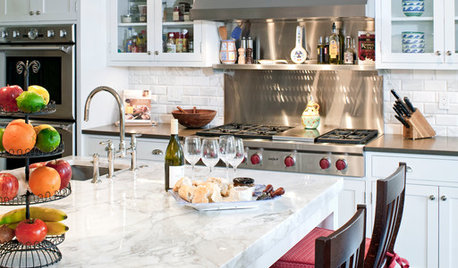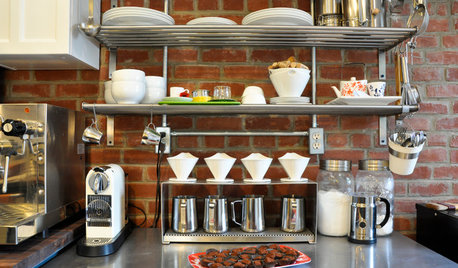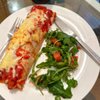Pastitsio Recipe help
Lulu
last year
Featured Answer
Sort by:Oldest
Comments (8)
Related Discussions
RECIPE: Help Need Bagel Recipe/ Ann t's?? i think?
Comments (4)Here you go and all you have to do to get Ann's wonderful cookbook is ask her. She shares. You might try emailing through GW. Tracey Bagels ====== Source: Hors d'oeuvres Cook Book. I have typed it exactly how the recipe is printed in the book. If you have a bread machine or kitchenaide by all means use it to do most of the kneading. I always like to finish the kneading by hand. You can also make these in to normal size bagels. I have used this recipe for over 20 years. I have tried other recipes but this is my favourite one. 2 cups warm water 2 packages active dry yeast 3 tablespoons sugar 1 tablespoon salt about 5 3/4 cups all-purpose flour, unsifted 3 quarts water with 1 tablespoon of sugar Cornmeal 1 egg yolk beaten with 1 tablespoon water about 2 tablespoons poppy or sesame seeds. . Stir together water and yeast in large bowl of electric mixer; let stand 5 minutes to soften yeast. Stir in the Sugar and Salt. Gradually mix in 4 cups of the flour and beat at medium speed for 5 minutes. With a spoon, stir in about 1 1/4 cups more flour to make a stiff dough. turn out on a floured board and knead until smooth, elastic, and no longer sticky, (about 15 minutes); add more flour as needed to prevent sticking - dough should be firmer than for most other yeast breads. Place in a greased bowl, cover, and let rise in a warm place until almost doubled ( about 40 minutes to 1 hour). Punch dough down and divide into thirds. Set 2/3 of dough aside on a floured board; cover with clear plastic. form remaining 1/3 dough in a log and cut into 16 equal pieces. To shape, knead each piece into small ball and poke thumbs through centre. With one thumb in hole (hole should be at least 1/2 inch) work fingers around perimeter, shaping ball into a small donutlike shape about 1 1/2 inches in diameter. Place bagels on a floured board or tray and let stand 20 minutes. Bring water-sugar mixture to a boil in a 4 to 5 quart pan; adjust heat to keep it boiling gently. Lightly grease a baking sheet and sprinkle with cornmeal. Lift bagels carefully and drop into water (about 6 at a time) boil gently for 1 minute turning only once (30 seconds each side). Lift out with slotted spoon and drain very briefly on paper towels, and place on baking sheet. Brush with 1/3 of the egg yolk glaze, sprinkle with seeds and bake in a 400° oven for 20 minutes or until richly browned. cool on racks. Repeat with remaining 2/3 dough (you may need to punch it down before shaping,) working with 1/3 at a time. Makes 48 cocktail size bagels....See MoreRECIPE: A few Greek recipes needed, please!
Comments (2)Hi, Michael Psilakis is my favorite chef in Greek recipes. Here are some my favorites: Feta Cheese Platter, Crispy Sweetbreads and Galaktoboureko. Well, I don't the complete recipes of these....See Morerecipe: help?? need xmas menu, lost recipe box!!
Comments (5)I feel your pain. Suggestion: try allrecipes.com,,they have some collections like Xmas extra with all of it together. That might help and you can do an advanced search where you put in name of recipe or main ingred you want or don't want in a recipe,,that could help you track down some lost stuff. Plus I like that they are rated and people tell how the dish turned out,,what improvements they made etc. I can bring up bread pudding without raisins or if I have extra bananas on hand I pulled it up using bananas in the bread pudding and got hits there too. About.com in their food section has some wonderful recipes that I've made for years and lots of collections too. Now you got your work cut out for you in deciding....that is the hardest part you know. I hope you have a great first hosting experience,,,just remember, it's just one meal,,this won't make or break a persons life. Why don't you ask some that are coming to "bring your favorite XYZ dish" to help you out? I've done those,,"I'll do the whole thing dinners" and by the time I'm thru, I'm too tired to enjoy it,,I'm broke and say I'm not doing this again. Or, how about ordering some stuff from Honey baked ham or whatever. Take advantage of Costco, they have great appetizers you can pop in the oven. I'm just thinking out loud here. Have a good one. Nicole...See MoreRECIPE: recipe: recipe: ewww!!! hunza!
Comments (6)This is the Logan Bread recipe my neighbors use. OK, it is not EXACTLY the same, but since it is several years old, I think the Hunza Bread people tweaked it some, and claimed it for their own. I typed in the introduction just as is on the recipe from my neighbors. Logan Bread: Logan Bread is a delicious, DENSE, chewy Bread that's VERY NUTRITIOUS and is ALMOST IMPERVIOUS to SPOILAGE! This makes a huge batch of sixty 2-inch squares, HIGH in Protein, Vitamins, and Minerals. Keeps weeks at Room Temperature, EVEN LONGER in the Fridge and INDEFINITELY in the Freezer. The Recipe for this WONDERFUL Bread is as follows - *4 lbs. (14 1/2 cups) Whole Wheat/Kamut or Spelt Flour *1 1/2 cups Sucanat (dehydrated Cane Juice) *1/2 cup Instant Dry (or Soy) Milk *1 tsp. Sea Salt *2 tsp. Rumford's (Non-Aluminum) Baking Powder *1 tsp. Cinnamon *1 tsp. ground Nutmeg *1 cup chopped Nuts (see below) *4 cups PURE Water *1 1/4 cups Honey *1 1/2 cups Blackstrap Molasses *1 1/4 cup Sunflower Oil (or other HEALTHY Oil) *2 cups Dried Fruit (see below). Preheat oven to 300oF.. To blended dry ingredients, add Water, then Honey, Molasses, Oil and Fruit. Pour batter about an inch thick into oiled Pans and bake 1 hr. Reduce oven to 200oF., leave door open slightly and continue to dry Bread for several hours. The LOWER the Moisture that is in the Bread, the LONGER that it will KEEP! NOTE: You can get these Ingredients from your local Food Coop and/or Health Food Store. If NEED be in an EMERGENCY, you could substitute other comparable and/or various other NUTRITIOUS Ingredients, if the ANY of above are NOT AVAILABLE!...See Moreplllog
last yearchloebud
last yearmorz8 - Washington Coast
last yearchloebud
last yearnekotish
last yearcarolb_w_fl_coastal_9b
last yearlast modified: last year
Related Stories

ENTRYWAYSDesign Recipes for a Fun and Functional Entry
These rooms in a variety of styles show how to create a welcoming first impression of your home
Full Story
HOUSEKEEPINGThree More Magic Words to Help the Housekeeping Get Done
As a follow-up to "How about now?" these three words can help you check more chores off your list
Full Story
ARCHITECTUREDesign Workshop: A Recipe for Inspiration in the New Year
Attention to craft, humble materials, mystery and more will influence my architecture work in 2015
Full Story
DECLUTTERINGDecluttering Help: What to Do When Nothing ‘Sparks Joy’
If the Marie Kondo phrase doesn’t help you decide what to keep and what to discard, try asking these 4 questions
Full Story
HOUSEKEEPING9 Kitchen Organizing Tips to Help You Waste Less Food
Follow these simple steps to maximize your budget and turn your good intentions into good habits
Full Story
KITCHEN DESIGNKitchen Recipes: Secret Ingredients of 5 One-of-a-Kind Cooking Spaces
Learn what went into these cooks’ kitchens — and what comes out of them
Full Story
KITCHEN DESIGNKitchen Recipes: 3 Real Cooks’ Kitchens
These families share the ingredients that went into their beloved kitchens and what they like to whip up in them
Full Story
CURB APPEALEntry Recipe: Contemporary Farmhouse Style in a Suburban Setting
This new build sets a neighborly tone with a front-yard patio and an exterior created in scale with other houses on the street
Full Story
LANDSCAPE DESIGNYour 3-Step Recipe for a Stylish Outdoor Room
Design your own retreat with ideas from a small rooftop garden, a contemporary courtyard and a modern oasis
Full Story
KITCHEN DESIGNSweet Ideas and a Truffle Recipe from a Chocolatier's Test Kitchen
A $2,100 budget didn't mean a half-baked kitchen redo; this confectioner just rolled up her sleeves and rolled out the improvements
Full StorySponsored
Central Ohio's Trusted Home Remodeler Specializing in Kitchens & Baths




chloebud